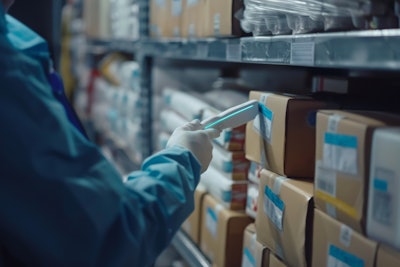
Food Logistics recently reported on challenges necessitating investment in new cold storage facilities. Where refrigeration systems are concerned, creating next-generation facilities is highly opportune.
In June, the U.S. EPA’s Significant New Alternatives Policy (SNAP) Rule 26 was finalized. This cleared the runway for refrigerant manufacturers to commercialize high-performing, significantly lower global warming potential (GWP) A2Ls—specifically, R-454A and R-454C—and for original equipment manufacturers (OEMs) to manufacture new systems using these refrigerants for commercial and industrial refrigeration applications. SNAP Rule 26 complements the American Innovation and Manufacturing (AIM) Act’s Technology Transitions Program to bring A2L refrigerant innovations to the doorsteps of cold storage facility operators and others along the commercial refrigeration cold chain who are looking for alternatives to high-GWP hydrofluorocarbons (HFCs).
Cold storage facility managers planning to construct or renovate space can expect to have a growing number of options for introducing equipment that offers the lower GWP, greater energy efficiency, high performance, and lower total cost of ownership associated with A2L refrigerants. Having more options means increased opportunity to select equipment that offers the best possible alignment with your facility’s refrigeration needs and environmental priorities. To follow are key insights about A2Ls to consider when building a refrigeration strategy for your cold storage facility.
Innovated for the environment
A2L refrigerants are a new generation of low-GWP hydrofluoroolefins (HFOs) and HFO-based blends that carry an ASHRAE mildly flammable classification. Recognizing environmental requirements on the horizon, refrigerant manufacturers like Chemours innovated A2Ls as solutions offering members of the HVAC and commercial refrigeration industries longevity in an evolving regulatory landscape. A2Ls have zero ozone depletion potential (ODP) and significantly lower GWP compared to hydrofluorocarbon (HFC) refrigerants. Two emerging A2Ls in commercial refrigeration—R-454A and R-454C—have GWPs of 239 (AR4) and 148 (AR4), respectively. In comparison, R-404A has a GWP of 3,920.
A2L formulation has also been influenced by the trend toward comprehensive energy management strategies employed across the cold chain. A2Ls support initiatives to replace old commercial refrigeration systems with ones that offer improved energy efficiency and have less environmental impact.
Alignment with the technology transition
SNAP Rule 26 and the Technology Transitions Program are integral to the larger industry transition to new-generation refrigerant solutions and provide critical support for the AIM Act’s phasedown of HFCs. Under the SNAP Program, the EPA identifies and evaluates substitutes for commercial refrigeration end uses that historically have used ozone-depleting substances. Substances are evaluated for their overall risk to human health and the environment, focusing on criteria such as ODP, GWP, flammability, toxicity, occupational and consumer health and safety, and environmental risks such as impact on ecosystems and local air quality. Rules under the Technology Transitions Program—which will start to impact the industry as early as Jan. 1, 2025—limit use of HFCs and support A2L adoption by calling for GWP limits for refrigerants based on specific applications. Points about A2L alignment with these initiatives as they pertain to cold storage facilities include:
· SNAP Rule 26—R-454A and R-454C are listed as acceptable alternatives, subject to use conditions, for cold storage warehouses. (R-454A and R-454C have been listed as acceptable alternatives in additional commercial refrigeration applications that can be found in the EPA SNAP 26 Fact Sheet.)
· Technology Transitions Program—as of January 1, 2026 new systems manufactured for cold storage warehouses will be required to use a refrigerant with a GWP of 150 or less for systems with a refrigerant charge of 200 lbs. or more, and a GWP of 300 or less for systems with a refrigerant charge under 200 lbs.
Excellent performance, efficiency and more
In addition to reducing the industry’s environmental impact, several other attributes make A2Ls attractive for cold storage facilities and other commercial refrigeration applications. A2Ls:
· Offer similar operating pressures and temperatures to refrigerants they are designed to replace
· Are engineered to balance key refrigerant properties—such as capacity, efficiency, and temperature glide—with GWP
· Are commercially available; equipment options are expanding
· Offer lower total cost of ownership (accounting for capital and operating costs) compared to CO2, especially in warmer-to-hotter ambient climates
· Have low toxicity and an advantageous safety profile compared to ammonia and hydrocarbon refrigerants
· Can be recovered, reclaimed, and reused—supporting maximum resource efficiency, minimal waste, and lower emissions
A2L equipment also supports efficiency of space. Much equipment globally is designed specifically for modulated systems and are engineered to deliver refrigeration where necessary without long line sets. This can be a distinct advantage over ammonia or CO2, systems that may require large industrial machine rooms.
Mild flammability
A2Ls, named for their ASHRAE safety classification of mild flammability and low toxicity, are for use in new equipment only. This mild flammability in part allows A2Ls to achieve lower GWP while optimizing refrigerant performance. Compared to A3s (hydrocarbons), A2Ls have lower burning velocities. They are also less likely to form flammable concentrations in the event of a leak and are significantly harder to ignite.
A2Ls have been used effectively and safely for approximately a decade. R-1234yf—a component in many A2L blends—charges air conditioners in approximately 90% of vehicles sold in the U.S. A2L standards require technicians to continue safety best practices they’ve been using for years and to adopt procedures for mildly flammable refrigerants. A2L equipment and tools are designed to support their safe use by, for example, having opposite-side threading on all A2L cylinders.
Multiple options for cold storage
Two new-generation A2L refrigerants gaining traction for cold storage facilities and other commercial refrigeration applications are R-454A and R-454C.
· R-454A—developed to replace legacy refrigerants such as R-404A. It is suitable for low- and medium-temperature commercial refrigeration applications. Systems with charge limits up to 200 lbs.—such as remote condensing units for food retail walk-ins and cascade systems—are ideal for R-454A. Offering a GWP under 300, this refrigerant was specifically designed to achieve better capacity and efficiency when compared to R-404A.
· R-454C—suitable for new systems in applications requiring a GWP of <150. Two examples being developed for supermarkets are small standalone units and larger system architectures with a charge size of >200 lbs. This refrigerant was designed to optimize capacity, temperature glide, and efficiency compared to R-404A while still maintaining a GWP of less than 150.
When selecting equipment, remember that low GWP is just one factor. For example, while ammonia has a “sweet spot” for certain commercial applications, its toxicity and flammability need to be considered. CO2 offers very low GWP and is nonflammable; however, where ambient temperatures exceed approximately 75°F, CO2 systems become inefficient and more costly to operate compared to A2Ls.
A2Ls: Engineered to grow with the industry and your business
The intersection of demand for cold storage facility construction and upgrades with regulatory approvals encouraging the manufacture of A2Ls and A2L systems offers commercial refrigeration businesses opportunities to make strategic investments supporting short- and long-term growth. The industry can expect to see more A2L options, allowing facility operators to select equipment that considers different refrigerant factors that may come into play—such as energy efficiency, capacity, normal boiling point, temperature glide, cost, and safety. Moreover, operators choosing to transition to A2Ls can have confidence their selection will advance decarbonization, circularity, and other critical environmental initiatives.



















